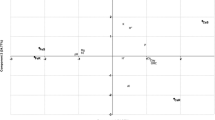Abstract
Bacillus polymyxa, Pseudomonas cepacia and Pseudomonas fluorescens are present in the rhizosphere of many crop plants. Little is known about microbial interactions in the rhizosphere. We investigated the type of interaction between these species under iron limitation. We found that, in mixed batch cultures, P. cepacia stimulates the growth of B. polymyxa and this stimulation can be observed also in low iron medium. Cell-free supernatants of cultures of P. fluorescens with various amounts of the siderophore pyoverdine also stimulate the growth of B. polymyxa. In this case we observed a positive correlation between pyoverdine concentration and growth stimulation. Purified pyoverdine also affects positively the growth of B. polymyxa.
Similar content being viewed by others
References
Bossier P, Hofte M, Verstraete W (1988) Ecological significance of siderophores in soil: In: Marshall KC (ed) Advances in microbial ecology, vol 10. Plenum Press, New York London, pp 385–412
Buyer JS, Sikora LJ (1990) Rhizosphere interactions and siderophores. Plant Soil 129: 101–107
Cacciari I, Lippi D, Ippoliti S, Pietrosanti T, Pietrosanti W (1989) Response to oxygen of diazotrophic Azosprillum brasilense-Arthrobacter giacomelloi mixed batch culture. Arch Microbiol 152: 111–114
Carson KC, Holliday S, Glenn AR, Dilworth MJ (1992) Siderophore and organic acid production in root nodule bacteria. Arch Microbiol 157: 264–271
Chanway CP, Holl FB, Turkington R (1988) Genotypic coadaptation in plant growth promotion of forage species by Bacillus polymyxa. Plant Soil 106: 281–284
Crowley DE, Wang YC, Reid Cpp, Szaniszlo PJ (1991) Mechanisms of iron acquisition from siderophores by microrganisms and plants. Plant Soil 130: 179–198
Csàky TZ (1948) On the estimation of hydroxylamine in biological materials. Acta Chem Scand 2: 450–454
Demange P, Wendenbaum S, Bateman A, Abdallah MA (1987) Bacterial siderophores: structure and physiochemical properties of pyoverdins and related compounds: In: Winkelmann G, van derHelm D, Neilands B (eds) Tron transport in microbes, plants and animals, VCH Publishers, New York, pp 167–187
Freitasde JR, Germida JJ (1991) Pseudomonas cepacia and Pseudomonas putida as winter wheat inoculants for biocontrol of Rhizoctonia solani. Can J Microbiol 37: 780–784
Halsall DM, Goodchild DJ (1986) Nitrogen fixation associated with development and localization of mixed populations of Cellulomonas spp. and Azospirillum brasilense grown on cellulose or wheat straw. Appl Environ Microbiol 51: 849–854
Hohnadel D, Meyer JM (1988) Specificity of pyoverdine-mediated iron uptake among fluorescent Pseudomonas strains. J Bacteriol 170: 4865–4873
Holl FB, Chanway CP, Turkington R, Radley RA (1988) Response of crested wheatgrass (Agropyron cristatum L.), perennial ryegrass (Lolium perenne L.) and wheat clover (Trifolium repens L.) to inoculation with Bacillus polymyxa. Soil Biol Biochem 20: 19–24
Huschka H, Naegeli HV, Leuenberger-Ryf H, Keller-Schierlein W, Winkelmann G (1985) Evidence for a common siderophore transport system but different siderophore receptors in Neurospora crassa. J Bacteriol 158: 686–688
Jagnow G (1983) Nitrogen-fixation (CH2-reduction) and growth of pure and mixed culture of Azospirillum lipoferum, Klebsiella sp. and Enterobacter sp. from cereal roots in liquid and semisolid media at different temperatures and oxygen concentrations. Experientia Suppl 48: 127–137
Jayaswal RK, Fernanandez MA, SchroederIII RG (1990) Isolation and characterization of a Pseudomonas strain that restricts growth of various phytopathogenic fungi. Appl Environ Microbiol 56: 1053–1058
Jurkevitch E, Hadar Y, Chen Y (1992) Differential siderophore utilization and iron uptake by soil and rhizosphere bacteria. Appl Environ Microbiol 58: 119–124
Leong J (1986) Siderophores: their biochemistry and possible role in the biocontrol of plant pathogens. Ann Rev Phytopathol 24: 187–209
Lindberg T, Granhall U (1984) Isolation and characterization of dinitrogen-fixing bacteria from the rhizosphere of temperate cereals and forage grasses. Appl Environ Microbiol 48: 683–689
Mavingui P, Laguerre G, Berge O, Heulin T (1992) Genetic and phenotipic diversity of Bacillus polymyxa in soil and in the wheat rhizosphere. Appl Environ Microbiol 58: 1894–1903
Meyer JM, Abdallah MA (1978) The fluorescent pigment of Pseudomonas fluorescens: biosynthesis, purification and physico-chemical properties. J Gen Microbiol 107: 319–328
Meyer JM, Abdallah MA (1980) The siderochromes of nonfluorescent pseudomonads: production of nocardamine by Pseudomonas stutzeri. J Gen Microbiol 118: 125–129
Meyer JM, Hohnadel D, Hallé F (1989) Cepabactin from Pseudomonas cepacia, a new type of siderophore. J Gen Microbiol 135: 1479–1487
Schroth MN, Hancock JG (1982) Disease-suppressive soil and root-colonizing bacteria. Science 216: 1376–1381
Schwyn B, Neilands JB (1987) Universal chemical assay for the detection and determination of siderophores. Anal Biochem 160: 47–56
Sokol PA (1986) Production and utilization of pyochelin by clinical isolates of Pseudomonas cepacia. J Clin Microbiol 23: 560–562
Tabacchioni S, Bevivino A, Chiarini L, Del Gallo M, Visca P (1992) Phenotypic differentiation of plant growth-promoting and human pathogen Pseudomonas cepacia strains. Proceedings of the 6th International Symposium on Microbial Ecology (ISME-6), 6–11 September, Barcelona, Spain
Weger LAde, Arendonk JJCMvan, Recourt K, Hofstad CAJMvan der, Weisbeek PJ, Lugtenberg B (1988) Siderophoremediated uptake of Fe3+ by the plant growth-stimulating Pseudomonas putida strain WCS358 and by other rhizosphere microrganisms. J Bacteriol 170: 4693–4698
Author information
Authors and Affiliations
Rights and permissions
About this article
Cite this article
Chiarini, L., Tabacchioni, S. & Bevivino, A. Interactions between rhizosphere microorganisms under iron limitation. Arch. Microbiol. 160, 68–73 (1993). https://doi.org/10.1007/BF00258147
Received:
Accepted:
Issue Date:
DOI: https://doi.org/10.1007/BF00258147




